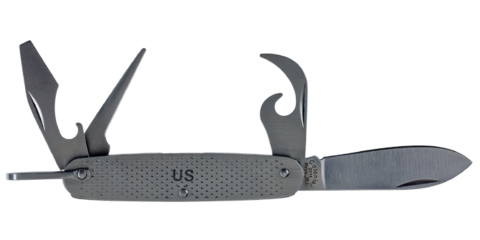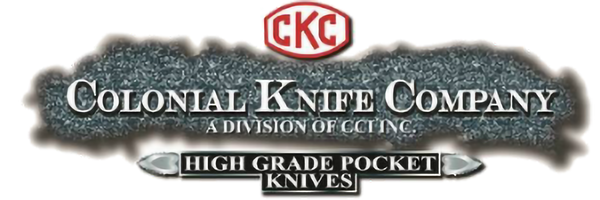
5110 00 162 2205 Knife, General Purpose
Share
When the United States suddenly entered World War II, there was an urgent need to equip thousands of recruits with the best gear in the shortest time possible. During 1942 many civilian sources and supplies of cutlery were quickly requisitioned. Thousands of four blade scout knives and civilian fixed blade hunters were taken into service. By late 1943, the United States was producing purpose built edge tools for the war effort, as the nation geared up to go on the offensive. Experience, mostly in fighting in the tropics and the desert, had shown that manufacturers needed to focus on two priorities: speed of production, and where possible resistance to extremes in weather.
In order to produce a high volume of knives in a short amount of time, steel stamping specified. The government turned to Rhode Island's cutlers. During the hard years of the Great Depression in the 1930's, Rhode Island cutlers had introduced to the United States new steel pressing and stamping technology making good quality knives, with names like "Forest Master" at a price that depression era scouts and their parents could afford. Since that need for cooperation to support the war effort was so great, several independent companies from New York and Rhode Island were merged for the duration of hostilities. It was decided that instead of procuring many variations of similar patterns, one general purpose knife should be standardized.
A version of the four blade scout knife was to be produced to military specifications as the Knife, General Purpose, Utility. Stamped stainless handles were chosen as both faster to manufacture and more resistant to hard use and weather than the bone and bolster handles used on traditional pre-depression era commercial scout knives. The stamping would also be pressed from thicker materiel than was used on the less costly versions of the Scout made during the depression, as the knives would be built to withstand the harshest conditions of battle. While stainless steels existed, heat treatment for the stainless steel knife blades and springs was initially neither fast nor as economical as producing these items from traditional carbon steels.
Perhaps the most important improvement for military use made to the pre-war scout knife was the perfected can-opener blade, invented by Rhode Island's own Michael Mirando. Earlier openers worked by inserting the blade into the can and cutting the top off from the inside out. This had left sharp jagged metal pointing outward, causing many cut fingers and hands. In wartime, these often became dangerous wounds, prone to infection. An American cutler by trade, Mirando was from an Italian knife making family. Mirando took out a US patent, number 2,391,732, for a can opener that was both simpler and safer than those used on scout knives previously. A simple steel stamping that formed an opposing pair of curved hooks, a short one to grab the edge of the can and act as a pivot, and a longer hook to open the can by forcing the edge to the can inward.
The Marines were the first branch of the military to receive a prototype version of the General Purpose utility knife with the improved opener in late 1943, according to some sources. The screwdriver-cap lifter is next to the knife blade, and the can opener is on the bail end. It seems that it wasn't realized initially that the reversal of the cutting direction of the opener necessitated moving the blade to the opposite end of the handle, for efficient use by right handed users.
